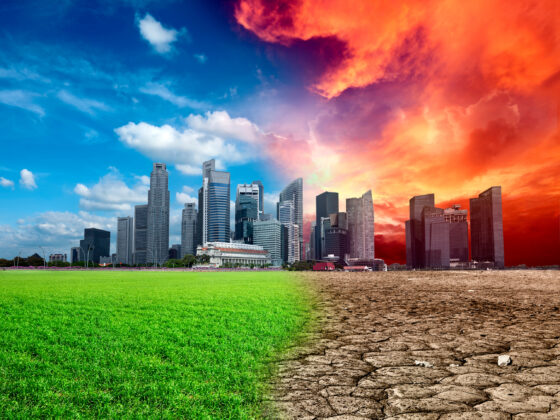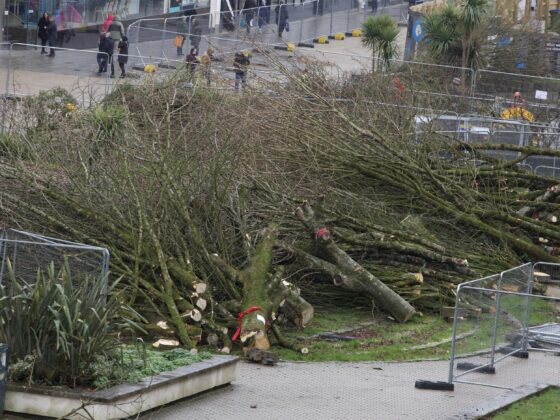This article is based on my previous post’s Twitter thread, an article that first appeared on American Thinker, and the exchanges that I’ve been having since.
TL;DR: Corporate green solutions are shams. Promote gardening if you care about fossil fuels. An accounting chicanery keeps natural emissions out of view. The hockey stick is actually about canopy loss. Switching to alley cropping would reverse it. Promote food sovereignty if you care about ending oppression. Share this if you’d like to do your bit.
The 27th desperate effort to save the planet has been unfolding this week. The usual charade of dignitaries who arrived in private jets to sermonize us about fossil fuels began on Sunday.
Looming food shortages might put land use tied to meat in the spotlight. Or not. This problem seems to be solving itself. Feed costs are prompting feedlot operators to thin their herds, even as schools are getting our kids used to eating bugs.
Another question mark is deep-sea mining. The Metals Company has just finished tearing down what few legal barriers stood in the way. The rest is just formality. Destroying our oceans to save the planet may seem offbeat, but mineral reserves are short. Our green tech transition demands that we mine more, faster.
Luckily, climate experts have sketched out options for us to stay on track despite these mining hurdles.
One is simply to use less energy. This makes sense, but no one wants to be told to lower their thermostat or drive less. You do that only when off-the-charts energy prices (or rationing) force you to. Or when blackouts rule out heating your home and charging your electric car.
Another option is to capture and sequester the carbon dioxide that comes out of industrial smokestacks. Fossil fuel giants love this idea. Pumping carbon dioxide down a well makes oil come up. The market potential is huge. They will be rebranding themselves as climate saviors in no time.
The last option is bio-sequestration. If you know anything about rocket mass heaters and hemp’s knack for soaking up toxins, this might conjure up the image of a smokestack piped inside a hemp field using a glorified drip irrigation system. But that would hurt carbon sequestration profits.
In practice, bio-sequestration stands for activities that range from benign ones like coastal restoration projects and regenerative livestock grazing to far less benign ones like tree planting and nature conservation projects.
The latter two are nothing short of malevolent, in fact. One’s wilderness is another’s home, and conservancies tend to mismanage nature after taking over. Mines are that much easier to open after kicking out the locals, you see. The park guards sometimes leave a few huts behind for the tourists.
In their defense, conservancy donors seldom know that they are funding big game hunting estates, safari tourism, commercial tree plantations (tree planting), and mining operations on stolen lands in developing countries.
It’s less defensible that environmental policy preachers don’t know that they’re promoting racist neocolonial policies. They’ll be thrilled to learn what they’re devoting their careers to if you politely tell them.
At the same time, exposing this egregious reality to them will not stop the climate agenda any more than debunking The Science ever did. A clique of “experts” is all that’s needed to keep the agenda going. What might stop it, however, is an oversight that I’d like to share with you.
The Science, you see, is not just wrong. It is so wrong it doesn’t even get the diagnosis right when you take the climate narrative at face value.
The proof of this arose out of the 2020 lockdowns. Two findings emerged. The first was that fossil fuel use dropped by only so much. The other was that atmospheric carbon increased like clockwork.
Explaining the fossil fuel use drop is straightforward. Take a supply chain, the violence needed to secure it, the job you need to buy what you’d like, and the parasites like bankers who facilitate this all. Food is what you use this Rube Goldberg machine for most. Food is huge. Heat is the runner-up.
It follows that the most effective way to reduce fossil fuel use is to promote gardening and urban farming. Concerned activists would be much better off doing just that. (Some do.) For heat, use a rocket mass heater. It allows to heat a home using stick wood without the usual soot and air pollution.
The low correlation between fossil fuels and atmospheric carbon is subtler. It derives from an accounting chicanery. Whereas industrial emissions get tracked, natural emissions get stashed inside a carbon stock black box.
This keeps natural emissions out of sight except for cherry-picked entries like meat. That makes sense only if avoidable natural emissions are small.
Forestry research shows that they are anything but. A cleared forest emits kilograms of carbon dioxide per square meter until the canopy recovers, or nothing at all if you leave a canopy behind by thinning instead. The precise number varies — on the order of 10 tons per acre is a good ballpark.
That’s a large amount. To put it in relatable terms, around 70 million acres of forest get harvested each year. Most of that gets cleared. This means that soil emissions tied to forestry compare with the industrial emissions of Germany. These emissions are trivial to avoid. Why are we ignoring them?
Farm fields emit too. In the past, hedgerows would keep the fungi alive, slow down the wind, and help soak up soil emissions. Nowadays, farm fields are more like cleared forests: wide open with no canopy. The soil emissions are such that you can tell when farmers are tilling or harvesting on NASA visualizations.
Natural emissions are so much larger than fossil fuel emissions that it’s not even a contest. The carbon hockey stick is soil, not oil. A recent research paper showed that a mere 12% of the carbon dioxide in the atmosphere is tied to fossil fuels. Climate experts were up in arms about statements in it, but 12% doesn’t seem off at all.
That number invites to take a closer look into NASA’s OCO-3 mission. The latter purports to be about locating the missing half of the carbon dioxide tied to fossil fuels. It seems safe to suggest that most fossil fuel emissions don’t make it further than the nearest plants.
At the same time, 12% is a lot higher than the ratio between industrial and natural emissions. Methinks the share of fossil fuel emissions comes from sources where wind carries those away before plants get to soak them up. Think planes, industrial chimneys, or a car in the desert.
At any rate, this all points to the carbon hockey stick being a canopy loss problem. Solving it would be a matter of not ending up with a wide open field without plants after tilling or harvesting. There are plenty of options to do this, like growing crops in between bands of trees or prairie species, or sowing crops directly into clover.
Switching to alley cropping is a good way to implement this: you get the benefit of hedgerows and you can still use machinery. The hockey stick began in the industrial era, so it stands to reason that alleys as wide as fields were in the past will be good enough. Alley cropping is profitable and allows to harvest more water when done right.
Harvesting water will allow to rehydrate a landscape or re-green a desert. You can do it slowly with shovels or at scale with bulldozers and seed pellets. You can then take it three steps further, by slowing down streams to make water soak into adjacent fields, by creating more streams using Bunyip pumps, and by harvesting run-of-the-river hydroelectricity.
It’s possible to regenerate our coasts, too. We could be creating seafood habitat around our shores. Aquatic ecosystems are much more productive than land-based ones. This could yield seafood; algae for feed, fertilizer, biofuels, or bioaccumulated minerals; and electricity from wave energy.
For completeness, the actual link between carbon dioxide and climate is soil. Soil with lower carbon content or less cover retains less water. This leads to water vapor (heat), water run-offs (erosion), and desertification: cycles of droughts and floods, dry landscapes prone to wildfires, habitat loss, you know the drill. Per above, we can reverse all of this.
I’ve replied to a number of objections since first writing about this, so let’s address the main ones upfront to wrap up.
The claim that this is a new form of climate change denialism is nonsense. Per above, we have a desertification problem that does a far better job at explaining (and solving) our environmental issues.
Claims that we actually track natural emissions are spurious. Researchers do so using models and economic data. How reliable is land-use change data when some trees hold as much carbon as a patch of jungle? And per above, these models keep sources of emissions that could be avoided out of view.
Claims that celebrate or question the merits of regenerative practices while clinging onto the fossil fuel narrative completely miss the point. The actual problem is not losing topsoil to begin with.
Claims that we still need to reduce fossil fuel emissions are simply wrong. Per above, a car’s tailpipe does not matter when plants are nearby, and hemp could soak up the emissions of industrial smokestacks. There are no good reasons to not burn fuels or make cement. Plus, nature loves having more carbon to play with.
Fossil fuel giants are still evil corporations, mind you. But then, so are other miners, other corporations, and the controlled opposition groups that they fund. Shop local if you don’t like malevolent corporations.
Another point relates to social injustice. Our system is wicked. At the same time, you’re not in a position to demand less oppression if you depend on it for food, so work on that. Suburbia has lots of lawns if you can’t afford land. Many homeowners will happily trade their lawn for free food.
The slew of indigenous concerns warrant a note also. Activists are almost all genuine. The causes they serve, much less so. Reparations and land back are transparent ploys to divide and conquer. Land rights and land reform, ploys to keep an oppressive top-down system in place. If it keeps you angry, passive, or entitled, it is controlled opposition.
The only real threat to elites is food sovereignty. Autonomous communities tend to want to handle their own legal affairs. That could lead to genuine land reform, a return of the commons, local currencies (a meal could be a good unit), no pollution (would you want to live next to a mine?), and so on. The Law is the problem, if you will — be it religious, regal, or other.
Food sovereignty and agroecology would also end world hunger. Those who claim otherwise do not understand gardening or fertility. Plus, food crises are seldom about harvests. They can usually be traced to poor or deliberate political decisions. The looming food crisis is no exception.
Put together, promote growing food if you care about fossil fuels; alley cropping if you care about the carbon hockey stick; food sovereignty if you care about ending oppression; and all of these things if you care about stopping the climate agenda.
Methinks this would work better than refuting the environmental narrative, because empowering others breeds hope. There is no more effective way to wake up a demoralized person than by empowering them enough to give them hope. The reason is that it is far easier to give hope than it is to dispel fear or despair. Hope is a potent weapon indeed.
As such, live empowered, and empower others at every opportunity. Share this far and wide if you want to do your bit to spread the word. In particular with your circles, local councils, media voices, farmers, loggers, activists, scientists, IPCC authors, and COP27 participants.
Denis de Bernardy helps create abundant ecosystems. His book, A Natural Language, exposes environmental big lies and puts solutions in front of the actual problems.














